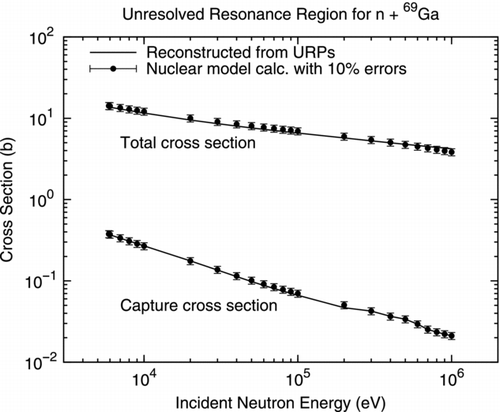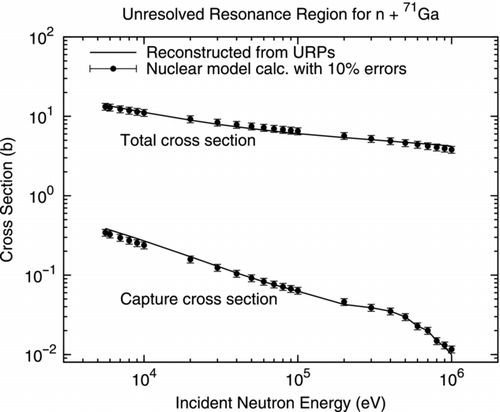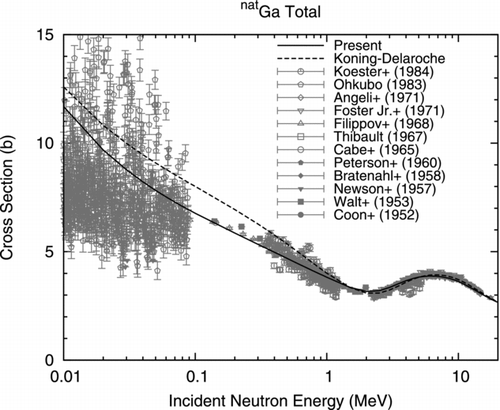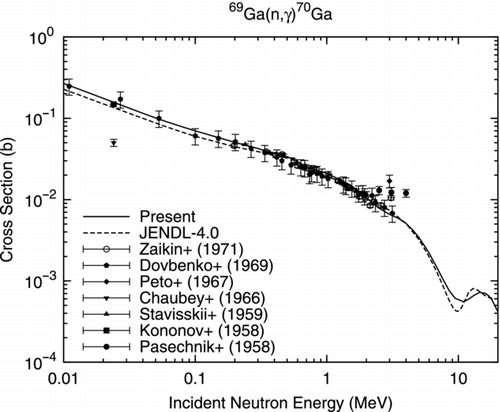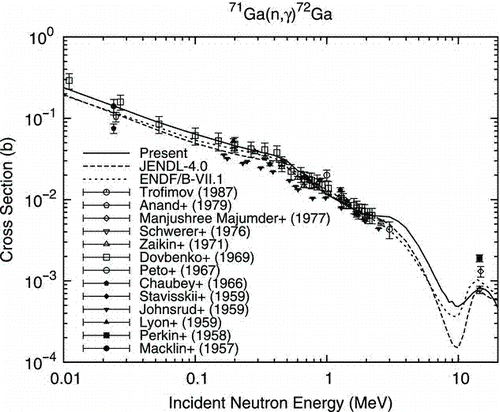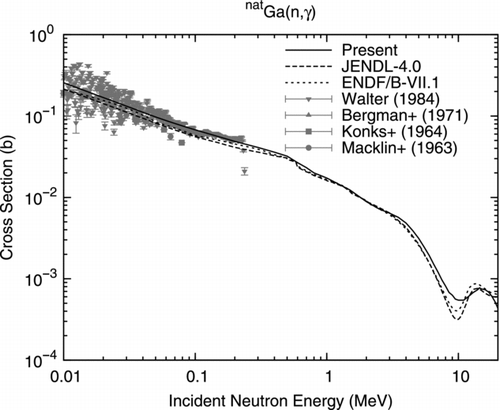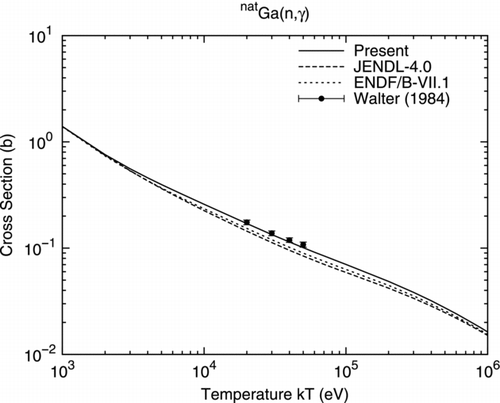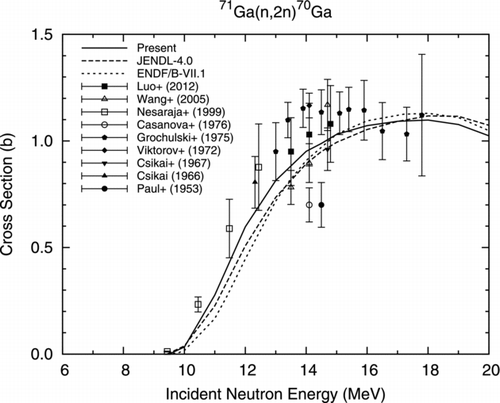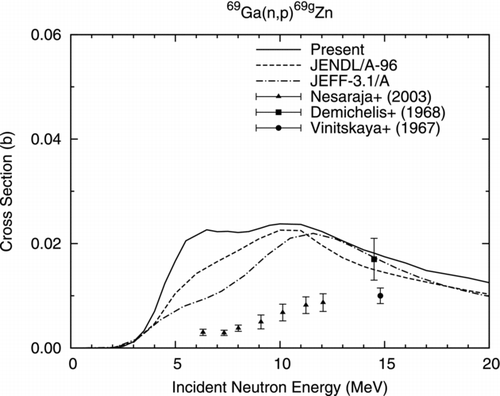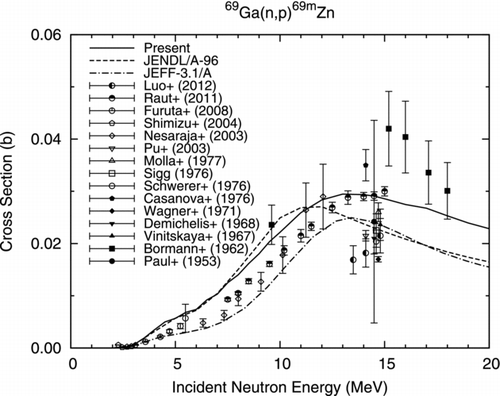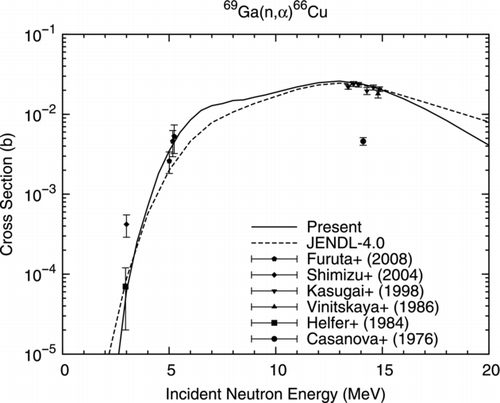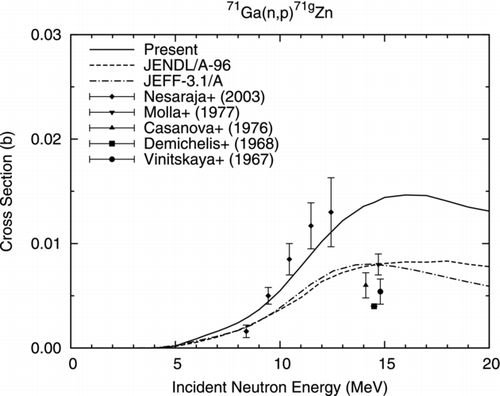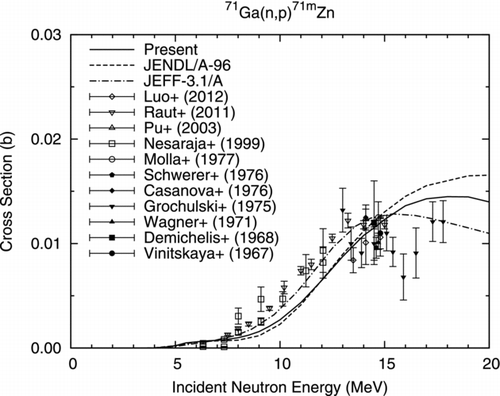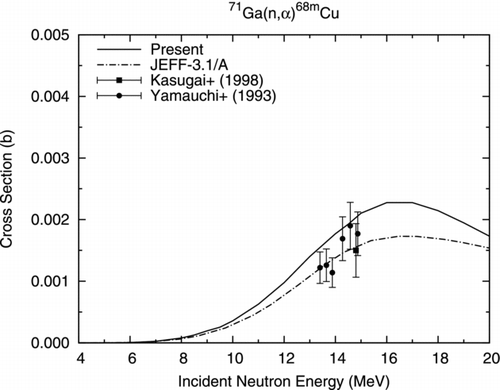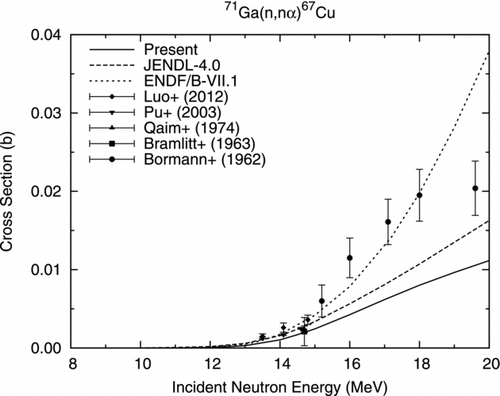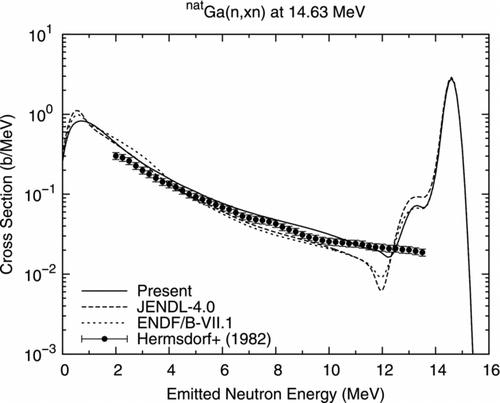Abstract
Neutron nuclear data on 69,71Ga have been evaluated for the next version of the Japanese Evaluated Nuclear Data Library (JENDL) general purpose file in the energy region from ![]() eV to 20 MeV. The resolved resonance parameters at negative energies were adjusted so as to reproduce measured thermal capture cross sections. The statistical model was applied to calculate the cross sections above the resolved resonance region. In the calculations, coupled-channel optical model parameters were used for neutrons. Pre-equilibrium and direct-reaction processes were taken into account in addition to the compound process. The present evaluation is consistent with available experimental data. The evaluated data are compiled into an ENDF-formatted data file.
eV to 20 MeV. The resolved resonance parameters at negative energies were adjusted so as to reproduce measured thermal capture cross sections. The statistical model was applied to calculate the cross sections above the resolved resonance region. In the calculations, coupled-channel optical model parameters were used for neutrons. Pre-equilibrium and direct-reaction processes were taken into account in addition to the compound process. The present evaluation is consistent with available experimental data. The evaluated data are compiled into an ENDF-formatted data file.
1. Introduction
The fourth version of the Japanese Evaluated Nuclear Data Library (JENDL-4.0 [Citation1]) was released in May 2010. In this library, 215 nuclides are regarded as fission products in the region from Z = 30 to 68. Although the resolved resonance parameters were examined by reviewing experimental data for all of those nuclides, the fast neutron region above resolved resonances was re-evaluated for about 170 nuclides due to the time limit. Hence, the fast-neutron cross sections for the rest of the fission-product nuclides may need improvements for the next version of the JENDL general purpose file. Gallium (Ga) isotopes are classified into such nuclides. Moreover, Ga is an important semiconductor material. Therefore, it is required to re-examine the cross sections of Ga.
Ga data were evaluated for JENDL-3.2 [Citation2] in 1994. The Ga data of JENDL-3.3 [Citation3] and JENDL-4.0 [Citation1] are essentially based on those of JENDL-3.2. In the 1994 evaluation, the statistical-model code CASTHY [Citation4] was used to calculate the total, elastic and inelastic scattering, and capture cross sections, while the cross sections for the competing reactions such as (n, 2n) and (n, p) were obtained from the multistep Hauser–Feshbach [Citation5] code GNASH [Citation6]. The direct inelastic scattering was considered by using the distorted-wave Born approximation (DWBA). However, gamma-ray production data were not compiled into the library.
The present work was undertaken to improve the evaluated data on stable Ga isotopes 69,71Ga by considering the latest knowledge on experimental and theoretical nuclear physics. Evaluated are the total, elastic and inelastic scattering, (n, γ), (n, p), (n, d), (n, t), ![]() , (n, α), (n, np), (n, nd), (n, nα), (n, 2n) and (n, 3n) reaction cross sections, the angular distributions of emitted neutrons and charged particles, and the energy distributions of emitted particles and gamma rays in the incident-neutron energy region from
, (n, α), (n, np), (n, nd), (n, nα), (n, 2n) and (n, 3n) reaction cross sections, the angular distributions of emitted neutrons and charged particles, and the energy distributions of emitted particles and gamma rays in the incident-neutron energy region from ![]() eV to 20 MeV. The Q values of the reactions were calculated from the 2003 version of the mass table (AME2003) obtained by Audi et al. [Citation7] and are listed in Table , together with isotopic abundances [Citation8]. The resolved resonance parameters at negative energies were modified so as to reproduce measured thermal capture cross sections. The unresolved resonance parameters (URPs) were obtained by fitting to the calculated total and (n, γ) cross sections.
eV to 20 MeV. The Q values of the reactions were calculated from the 2003 version of the mass table (AME2003) obtained by Audi et al. [Citation7] and are listed in Table , together with isotopic abundances [Citation8]. The resolved resonance parameters at negative energies were modified so as to reproduce measured thermal capture cross sections. The unresolved resonance parameters (URPs) were obtained by fitting to the calculated total and (n, γ) cross sections.
Table 1 Isotopic abundances and reaction Q values of stable Ga isotopes
This paper presents how the evaluation was performed. Section 2 deals with the resonance parameters. In Section 3, the computational methods and procedures are described. Comparisons of the evaluated results with available experimental data and evaluated data are made in Section 4. Finally, Section 5 summarizes the conclusion.
2. Resonance parameters
The upper boundaries of the resolved resonance regions were set to 5.9 keV and 5.6 keV for 69,71Ga, respectively, in JENDL-4.0. No new resolved resonance parameters are available experimentally. However, in this work, attention was paid to thermal capture cross sections. Measured thermal capture cross sections are listed in Table . The JENDL-4.0 evaluation is completely based on the data of Koester et al. [Citation10], which deviate from the other measurements for both nuclides. The capture cross sections of Koester et al. were obtained from their measured total and scattering cross sections, while the other measurements were derived by using the activation method. As for 71Ga, Uddin et al. [Citation17] obtained a capture cross section of 2.75 ± 0.14 b at 0.0536 eV by using the activation method. The capture cross sections ordinarily obey the 1/v law, where v stands for the velocity of the incident neutron. The value of Uddin et al. would amount to 4.00±0.20 b at 0.0253 eV. In the present work, it was judged that the thermal capture cross section of JENDL-4.0 is too large for 69Ga but too small for 71Ga. Consequently, the resonance parameters at negative energies for both isotopes were re-adjusted so as to be consistent with the capture cross sections measured by the activation method. The thermal cross sections are given in Table , where the capture cross sections are given at 300 K and the elastic scattering cross sections at 0 K. It is found from the table that the presently evaluated results are in better agreement with the recommendations of Mughabghab [Citation18] than the JENDL-4.0 evaluations except for the elastic scattering cross section of 71Ga.
Table 2 Experimental data on thermal capture cross sections of 69,71Ga
Table 3 Thermal cross sections of 69,71Ga
The ASREP code [Citation19] was used to determine the URPs by fitting to the total and capture cross sections evaluated by the nuclear model calculations described in the following section. The unresolved resonance regions are 5.9 keV–1 MeV for 69Ga and 5.6 keV–1 MeV for 71Ga. It should be noted that the URPs obtained are used only for self-shielding calculations, since the point-wise cross sections are given in the evaluated data files. The cross sections of 69Ga and 71Ga reconstructed from the URPs presently obtained are compared with the total and capture cross sections calculated from the nuclear models in Figures and , respectively. In the parameter fitting, 10% errors of the nuclear model calculations were assumed. It is found from the figures that the reconstructed cross sections reproduce the nuclear model calculations very well.
3. Computational methods and procedures above the resonance region
3.1. Nuclear models
The POD code [Citation20] was used for calculating the neutron-induced reaction cross sections of Ga isotopes. The code is based on the spherical optical model, the one-component exciton pre-equilibrium model, the DWBA, and the multistep statistical model. In order to simulate the direct and semidirect effects on the capture reaction, the pre-equilibrium capture was considered by using the gamma-ray emission rate derived by Akkermans and Gruppelaar [Citation21]. The original POD code was modified to allow for options of gamma-ray strength functions, i.e. generalized, extended generalized, and modified Lorentzians [Citation22, Citation23] (hereafter GLO, EGLO, and MLO, respectively) for E1 radiation, in addition to the standard Lorentzian.
The POD code is not capable of calculating direct reaction cross sections and transmission coefficients by the coupled-channel method. These two kinds of data are supplied to POD by a separate coupled-channel code if the use of the coupled-channel method is preferable. In the present work, the coupled-channel optical model code OPTMAN [Citation24] supplied those values to the POD code.
3.2. Parameter determination
3.2.1. Optical-model potentials
We employed the global neutron optical-model parameters obtained by Kunieda et al. [Citation25] using the coupled-channel method based on the rigid-rotator model [Citation26]. The coupling schemes and deformation parameters are listed in Table . The calculated total cross section of elemental Ga is illustrated in Figure , together with experimental data and the spherical optical model calculations using the parameters of Koning and Delaroche [Citation27]. It is found from the figure that the present calculations are in good agreement with the experimental data in the entire energy region. The spherical optical model parameters of Koning and Delaroche yield large cross sections in the energy region below 1 MeV. Built-in values in POD were used for charged-particle optical-model parameters, i.e. the values of Koning and Delaroche [Citation27] for protons, those of Lohr and Haeberli [Citation28] for deuterons, those of Becchetti and Greenlees [Citation29] for tritons and 3He, and those of Lemos [Citation30] potentials modified by Arthur and Young [Citation31] for α particles. The values of Lohr–Haeberli and Becchetti–Greenlees potentials were actually taken from the compilation of Perey and Perey [Citation32].
Table 4 Coupling schemes used in the interaction between neutrons and targets
3.2.2. Discrete levels and level density
In the present calculation, it was necessary to input the discrete levels and level density parameters for 16 nuclei, i.e. 67–72Ga, 67–71Zn and 65–69Cu. The discrete levels were taken from the reference input parameter library (RIPL-3) [Citation33].
Concerning the level density, the composite formula of Gilbert and Cameron [Citation34] was used in the present work. In the region of low excitation energy E, the level density is described by the constant temperature formula
Table 5 Level density parameters for each nucleus
3.2.3. Gamma-ray transition
The GLO form was used for E1 radiation in the present work, since the calculations with GLO could reproduce measured gamma-ray spectra for other nuclei [Citation37–Citation Citation39] satisfactorily. The giant resonance parameters were taken from the compilation of Kopecky [Citation40]. The resonance energy and width parameters are given by
Table 6 Gamma-ray strength functions for s-wave neutrons in units of 10−4
3.2.4. Pre-equilibrium parameters
For pre-equilibrium capture, Lorentzian-shaped photon absorption cross sections are required [Citation21] to calculate the gamma-ray emission rate. The resonance energy and width are given in Equations (Equation3) and (Equation4), respectively. The peak cross section is given [Citation40] by
Table 7 Pre-equilibrium parameters used in the present work
4. Comparison with experimental and other evaluated data in the fast neutron energy region
The presently evaluated data are compared with experimental and other evaluated data. The experimental data are taken from the EXFOR database [Citation42], which is available in the international data centers, such as the OECD/NEA Data Bank. As for the general-purpose nuclear data, there are three major libraries, i.e. JENDL-4.0 [Citation1], ENDF/B-VII.1 [Citation43], and JEFF-3.1.2. [Citation44]. Only elemental Ga data that were taken from JEND-3.2 [Citation2] are contained in JEFF-3.1.2. In the fast neutron energy regions, 69Ga and 71Ga of ENDF/B-VII.1 were taken from JENDL-3.3 [Citation3] and CENDL-3 [Citation45], respectively. As described in Section 1, the Ga data of JENDL-4.0 are almost the same as those for JENDL-3.2 and JENDL-3.3. Identical evaluated data are not drawn in the following figures. It should be noted that the general-purpose libraries do not contain any partial activation cross sections leading to the ground or isomeric state. The activation cross-section files JENDL/A-96 [Citation46] and JEFF-3.1/A [Citation47] are used for comparison with such activation data.
The radiative capture cross sections of 69Ga and 71Ga are illustrated in Figures and , respectively. The presently evaluated cross sections are in good agreement with measurements, but slightly larger than the JENDL-4.0 values. It is found from Figure that the present evaluation reproduces measured elemental data below 200 keV. Figure shows the Maxwellian-averaged capture cross sections of elemental Ga as a function of kT. The present evaluation is consistent with the data of Walter [Citation48] at kT = 20–50 keV, while the JENDL-4.0 and ENDF/B-VII.1 evaluations are slightly lower than them.
The (n, 2n) reaction cross sections are shown in Figures – . As for 69Ga, the present evaluation goes through the recent measurements [Citation49–Citation Citation Citation52], but is much smaller than the data of Bormann et al. [Citation53] especially above 15 MeV. Although they provide important activation data in a wide energy range, the measured data are sometimes considerably larger than other experimental data or evaluated data, as seen in Refs. [Citation39, Citation54, Citation55]. After changing various model parameters, it was found that fitting to the data of Bormann et al. [Citation53] led to poor reproduction of the other reaction cross sections of 69Ga. Therefore, the solid curve in Figure was finally adopted as our evaluation. On the other hand, the measured data of 71Ga are well reproduced by the present evaluation, which is almost consistent with JENDL-4.0 and ENDF/B-VII.1. Concerning elemental data, the data of Frehaut et al. [Citation56] are solely available. However, it is well known that their measurements are systematically smaller than others. Vonach et al. [Citation57] suggested that a normalization factor of 1.078 be applied to all of their data. In Figure , the data multiplied by the normalization factor are also shown. In the energy region below 15 MeV, all the evaluated data agree with the renormalized data of Frehaut et al.
The charged-particle emission cross sections are shown in Figures –. On the whole, the present statistical-model calculations are in good agreement with experimental data except for a few cases. The 69Ga(n, p)69g Zn cross sections, which were measured by Nesaraja et al. [Citation58] using an enriched sample (0.46% for 69Ga and 99.54% for 71Ga) and β− counting in the energy region from 6 to 12 MeV, are not reproduced by all the evaluations, although the evaluations are consistent with the measurement of Demichelis et al. [Citation59] at 14 MeV. Considering the very small isotopic composition of 69Ga, the present work did not place emphasis on the experiment of Nesaraja et al. for 69Ga(n, p)69g Zn. Concerning the 71Ga(n, p)71g Zn reaction, the present evaluation laid weight on the measurements of Nesaraja et al. [Citation58], whereas JENDL/A-96 and JEFF-3.1/A are obviously based on the data of Molla and Qaim [Citation60]. As for the 71Ga(n, nα)67Cu reaction, both the present and JENDL-4.0 evaluations are smaller than the experimental data of Bormann et al. [Citation61] above 15 MeV, although those evaluations are almost consistent with the other measurements around 14 MeV. The calculation attempted to reproduce experimental data on as many reactions as possible rather than to focus on a particular experimental data set. Therefore, the inconsistency with the data of Bormann et al. was allowed in this work.
The neutron emission spectra of elemental Ga are illustrated in Figure at an incident neutron energy of 14.63 MeV. It is found from the figure that the present evaluation is in good agreement with the data measured by Hermsdorf et al. [Citation62]. JENDL-4.0 and ENDF/B-VII.1 slightly underestimate the measurements between 10 and 12 MeV. The spectra below 4 MeV are essentially formed by the (n, 2n) reaction. As mentioned above, the 69Ga(n, 2n) cross section was reduced by 9% at 14.5 MeV compared with the JENDL-4.0 evaluation. This reduction does not cause any deficiencies in the low-energy spectra, although the measurements are available down to 2 MeV.
5. Concluding remarks
The neutron nuclear data of 69,71Ga were evaluated in the energy region from 10−5 eV to 20 MeV. The resolved resonance parameters at negative energies were adjusted so as to reproduce the measured thermal capture cross sections of both isotopes, while the other resolved resonance parameters remain unchanged from JENDL-4.0. The URPs were obtained for self-shielding calculations by fitting to total and capture cross sections calculated from the nuclear models.
Above the resolved resonance region, the present evaluation is mainly based on the statistical model using the POD code. The neutron transmission coefficients were obtained by the coupled-channel method, together with the total cross sections, the shape elastic scattering cross sections and the direct-reaction components of the inelastic scattering cross sections. On the whole, the presently evaluated cross sections are in good agreement with available experimental data, and better than the JENDL-4.0 data. Moreover, the gamma-ray production data, which were missing in JENDL-4.0, were newly evaluated. The evaluated data are compiled into an ENDF-formatted data file for the next release of the JENDL general purpose file.
Acknowledgements
The author would like to thank the members of the Nuclear Data Center, Japan Atomic Energy Agency, for their helpful comments on this work.
Notes
aThe numbers in parentheses indicate the excitation energy in MeV.
References
- Shibata , K , Iwamoto , O , Nakagawa , T , Iwamoto , N , Ichihara , A , Kunieda , S , Chiba , S , Furutaka , K , Otuka , N , Ohsawa , T , Murata , T , Matsunobu , H , Zukeran , A , Kamada , S and Katakura , J . 2011 . JENDL-4.0: a new library for nuclear science and engineering . J Nucl Sci Technol. , 48 : 1 – 30 . doi: 10.1080/18811248.2011.9711675
- Nakagawa , T , Shibata , K , Chiba , S , Fukahori , T , Nakajima , Y , Kikuchi , Y , Kawano , T , Kanda , Y , Ohsawa , T , Matsunobu , H , Kawai , M , Zukeran , A , Watanabe , T , Igarasi , S , Kosako , K and Asami , T . 1995 . Japanese evaluated nuclear data library version 3 revision-2: JENDL-3.2 . J Nucl Sci Technol. , 32 : 1259 – 1271 . doi: 10.1080/18811248.1995.9731849
- Shibata , K , Kawano , T , Nakagawa , T , Iwamoto , O , Katakura , J , Fukahori , T , Chiba , S , Hasegawa , A , Murata , T , Matsunobu , H , Ohsawa , T , Nakajima , Y , Yoshida , T , Zukeran , A , Kawai , M , Baba , M , Ishikawa , M , Asami , T , Watanabe , T , Watanabe , Y , Igashira , M , Yamamuro , N , Kitazawa , H , Yamano , N and Takano , H . 2002 . Japanese evaluated nuclear data library version 3 revision-3: JENDL-3.3 . J Nucl Sci Technol. , 39 : 1125 – 1136 . doi: 10.1080/18811248.2002.9715303
- Igarasi , S and Fukahori , T . 1991 . Program CASTHY: statistical model calculation for neutron cross sections and gamma ray spectrum (JAERI 1321) , Tokai : Japan Atomic Energy Research Institute .
- Hauser , W and Feshbach , H . 1952 . The inelastic scattering of neutrons . Phys Rev. , 87 : 366 – 373 . doi: 10.1103/PhysRev.87.366
- Young , P G , Arthur , E D and Chadwick , M B . 1992 . Comprehensive nuclear model calculations: introduction to the theory and use of the GNASH code (LA-12343-MS) , Los Alamos : Los Alamos National Laboratory .
- Audi , G , Wapstra , A H and Thibault , C . 2003 . The AME2003 atomic mass evaluation (II) . Tables, graphs and references. Nucl Phys A. , 729 : 337 – 676 . doi: 10.1016/j.nuclphysa.2003.11.003
- Berglund , M and Wieser , M E . 2011 . Isotopic compositions of the elements 2009 (IUPAC technical report) . Pure Appl Chem. , 83 : 397 – 410 . doi: 10.1351/PAC-REP-10-06-02
- Son , P N , Anh , T T , Vu , C D and Tan , V H . 2011 . Measurement of thermal neutron cross-section and resonance integrals of the 69Ga(n, γ)70Ga and 71Ga(n, γ)72Ga reactions at Dalat research reactor . J Korean Phys Soc. , 59 : 1761 – 1764 . doi: 10.3938/jkps.59.1761
- Koester , L , Knopf , K , Waschkowski , W and Klüver , A . 1984 . Interactions of neutrons with gallium and its isotopes . Z Phys A. , 318 : 347 – 356 . doi: 10.1007/BF01418094
- Ryves , T B . 1971 . Further activation thermal neutron capture cross-sections and resonance integrals . J Nucl Energy , 25 : 129 – 131 . doi: 10.1016/0022-3107(71)90018-9
- Pomerance , H . 1952 . Thermal neutron capture cross sections . Phys Rev. , 88 : 412 – 413 . doi: 10.1103/PhysRev.88.412
- Seren , L , Friedlander , H N and Turkel , S H . 1947 . Thermal neutron activation cross sections . Phys Rev. , 72 : 888 – 901 . doi: 10.1103/PhysRev.72.888
- Karadag , M , Yücel , H , Tan , M and Özmen , A . 2003 . Measurement of thermal neutron cross-sections and resonance integrals for 71Ga(n, γ)72Ga and 75As(n, γ)76As by using 241Am-Be isotopic neutron source . Nucl Instrum Meth Phys Res A. , 501 : 524 – 535 . doi: 10.1016/S0168-9002(03)00408-X
- Huang , X L , Han , X G , Yu , W X , Lu , H L and Zhao , W R . 2000 . Measurement of thermal neutron capture cross section . Atomic Energy Sci Technol , 34 : 456 – 459 . in Chinese
- Gleason , G . 1975 . Thermal neutron cross sections and (n, γ) resonance integrals Part I . Radiochem Radioanal Lett. , 23 : 317 – 323 .
- Uddin , M S , Chowdhury , M H , Hossain , S M , Latif , Sk A , Hafiz , M A , Islam , M A , Zakaria , A KM , Yunus , S M and Azharul , Islam SM . 2008 . Measurement of neutron capture cross-section of the 71Ga(n, γ)72Ga reaction at 0.0536 eV energy . Nucl Instrum Meth Phys Res B. , 266 : 3341 – 3345 . doi: 10.1016/j.nimb.2008.04.019
- Mughabghab , S F . 2006 . Atlas of neutron resonances, resonance parameters and thermal cross sections Z=1–100 , Amsterdam : Elsevier . ISBN-13: 978-0-444-52035-7
- Kikuchi , Y , Nakagawa , T and Nakajima , Y . 1999 . ASREP: a computer program for automatic search of unresolved resonance parameters (JAERI-Data/Code 99-025) , Tokai : Japan Atomic Energy Research Institute . in Japanese
- Ichihara , A , Iwamoto , O , Chiba , S , Kunieda , S and Shibata , K . 2007 . Program POD; a computer code to calculate cross sections for neutron-induced nuclear reactions (JAEA-Data/Code 2007-012) , Tokai : Japan Atomic Energy Agency .
- Akkermans , J M and Gruppelaar , H . 1985 . Analysis of continuum gamma-ray emission in precompound-decay reactions . Phys Lett B. , 157 : 95 – 100 . doi: 10.1016/0370-2693(85)91524-2
- Kopecky , J , Uhl , M and Chrien , R E . 1993 . Radiative strength in the compound nucleus 157Gd . Phys Rev C. , 47 : 312 – 322 . doi: 10.1103/PhysRevC.47.312
- Plujko , V A , Ezhov , S N , Kavatsyuk , M O , Grebenyuk , A A and Yermolenko , R V . 2002 . Testing and improvements of gamma-ray strength functions for nuclear model calculations . J Nucl Sci Technol Suppl. , 2 : 811 – 814 .
- Soukhovitski , E Sh , Chiba , S , Iwamoto , O , Shibata , K , Fukahori , T and Morogovskij , G B . 2005 . Programs of OPTMAN and SHEMMAN version 8 (2004) (JAERI-Data/Code 2005-002) , Tokai : Japan Atomic Energy Research Institute .
- Kunieda , S , Chiba , S , Shibata , K , Ichihara , A and Sukhovitskiĩ , E Sh . 2007 . Coupled-channels optical model analyses of nucleon-induced reactions for medium and heavy nuclei in the energy region from 1 keV to 200 MeV . J Nucl Sci Technol. , 44 : 838 – 852 . doi: 10.1080/18811248.2007.9711321
- Tamura , T . 1965 . Analyses of the scattering of nuclear particles by collective nuclei in terms of the coupled-channel calculation . Rev Mod Phys. , 37 : 679 – 708 . doi: 10.1103/RevModPhys.37.679
- Koning , A J and Delaroche , J P . 2003 . Local and global nucleon optical models from 1 keV to 200 MeV . Nucl Phys A. , 713 : 231 – 310 . doi: 10.1016/S0375-9474(02)01321-0
- Lohr , J M and Haeberli , W . 1974 . Elastic scattering of 9–13 MeV vector polarized deuterons . Nucl Phys A. , 232 : 381 – 397 . doi: 10.1016/0375-9474(74)90627-7
- Becchetti , F D Jr and Greenlees , G W . 1971 . “ A general set of 3 He and triton optical-model potentials for A > 40, E < 40 MeV ” . In Proceedings of the 3rd International Symposium on Polarization Phenomena in Nuclear Reactions , Edited by: Barshall , H H and Haeberli , W . Wisconsin , , USA : University of Wisconsin Press . Madison. 1970 August 31–September 4
- Lemos , O F . 1972 . Diffusion élastique de particules alpha de 21 à 29.6 MeV sur des Noyaux de la Région Ti-Zn [dissertation] (Orsay report, Series A., No. 136) Université de Paris-sud ,
- Arthur , E D and Young , P G . 1980 . Evaluated neutron-induced cross sections for 54,56Fe to 40 MeV (LA-8626-MS) , Los Alamos : Los Alamos National Laboratory .
- Perey , C M and Perey , F G . 1976 . Compilation of phenomenological optical-model parameters 1954–1975 . At Data Nucl Data Tables , 17 : 1 – 101 . doi: 10.1016/0092-640X(76)90007-3
- Capote , R , Herman , M , Obložinský , P , Young , P G , Goriely , S , Belgaya , T , Ignatyuk , A V , Koning , A J , Hilaire , S , Plujko , V A , Avrigeanu , M , Bersillon , O , Chadwick , M B , Fukahori , T , Ge , Z , Han , Y , Kailas , S , Kopecky , J , Maslov , V M , Reffo , G , Sin , M , Soukhovistskii , E. Sh and Talou , P . 2009 . RIPL: reference input parameter library for calculations of nuclear reactions and nuclear data evaluations . Nucl Data Sheets. , 110 : 3107 – 3214 . doi: 10.1016/j.nds.2009.10.004
- Gilbert , A and Cameron , A GW . 1965 . A composite nuclear-level density formula with shell corrections . Can J Phys. , 43 : 1446 – 1496 . doi: 10.1139/p65-139
- Mengoni , A and Nakajima , Y . 1994 . Fermi-gas model parametrization of nuclear level density . J Nucl Sci Technol. , 31 : 151 – 162 . doi: 10.1080/18811248.1994.9735131
- Mengoni , A and Nakajima , Y . 1993 . HERMES: a personal-computer program for calculation of the fermi-gas model parameters of nuclear level density (JAERI-M 93-177) , Tokai : Japan Atomic Energy Research Institute .
- Shibata , K . 2007 . Calculation of neutron nuclear data on calcium isotopes for JENDL-4 . J Nucl Sci Technol. , 44 : 10 – 20 . doi: 10.1080/18811248.2007.9711251
- Shibata , K and Kunieda , S . 2008 . Calculation of neutron nuclear data on silicon isotopes for JENDL-4 . J Nucl Sci Technol. , 45 : 123 – 137 . doi: 10.1080/18811248.2008.9711422
- Shibata , K , Ichihara , A and Kunieda , S . 2009 . Calculation of neutron nuclear data on molybdenum isotopes for JENDL-4 . J Nucl Sci Technol. , 46 : 278 – 288 . doi: 10.1080/18811248.2007.9711531
- Kopecky , J . 1998 . Gamma-Ray strength functions (IAEA-TECDOC-1034) , 97 – 111 . Vienna : International Atomic Energy Agency .
- Benzi , V , Maino , G , Menapace , E and Ventura , A . BCS level density calculations and consistent estimate of radiative widths by means of a thermodynamic model . In: Coceva C, Panini GC, editors. Proceedings of Specialists’ Meeting on Neutron Cross Sections of Fission Product Nuclei . December , Bologna , Italy. Bologna : Comitato Nazionale Energia Nucleare .
- Schwerer , O . 2008 . EXFOR formats description for users (EXFOR basics) (IAEA-NDS-206) , Vienna : International Atomic Energy Agency .
- Chadwick , M B , Herman , M , Obložinský , P , Dunn , M , Danon , Y , Kahler , A C , Smith , D L , Pritychenko , B , Arbanas , G , Arcilla , R , Brewer , R , Brown , D A , Capote , R , Carlson , A D , Cho , Y S , Derrien , H , Guber , K , Hale , G M , Hoblit , S , Holloway , S , Johnson , T D , Kawano , T , Kiedrowski , B C , Kim , H , Kunieda , S , Larson , N M , Leal , L , Lestone , J P , Little , R C , McCutchan , E A , MacFarlane , R E , Macinnes , M , Mattoon , C M , McKnight , R D , Mughabghab , S F , Nobre , G PA , Palmiotti , G , Palumbo , A , Pigni , M T , Pronyaev , V G , Sayer , R O , Sonzogni , A A , Summers , N C , Talou , P , Thompson , I J , Trkov , A , Vogt , R L , van der Marck , S C , Wallner , A , White , M C , Wiadra , D and Young , P G . 2011 . ENDF/B-VII.1 nuclear data for science and technology: cross sections, covariances, fission product yields and decay data . Nucl Data Sheets. , 112 : 2887 – 2996 . doi: 10.1016/j.nds.2011.11.002
- OECD . Nuclear Energy Agency Data Bank Available from: http://www.oecd-nea.org/dbforms/data/eva/evatapes/jeff_31/JEFF312/
- Ge , Z G , Zhao , Z X , Xia , H H , Zhuang , Y X , Liu , T J , Zhang , J S and Wu , H C . 2011 . The updated version of Chinese evaluated nuclear data library (CENDL-3.1) . J Korean Phys Soc. , 59 : 1052 – 1056 . doi: 10.3938/jkps.59.1052
- Nakajima , Y . JENDL activation cross section file . In: Igashira M, Nakagawa T, editors. Proceedings of the 1990 Symposium on Nuclear Data . Tokai , , Japan : Japan Atomic Energy Research Institute . 1990 November 29-30; Tokai, Japan
- Koning , A , Forrest , R , Kellett , M , Mills , R , Henriksson , H and Rugama , Y , eds. 2006 . The JEFF-3.1 nuclear data library (JEFF Report 21) , Paris : OECD Nuclear Energy Agency .
- Walter , G . 1984 . Temperatur und neutronendichte der schwachen komponente des S-prozesses (KFK-3706) , Karlsruhe : Kernforschunsgzentrum Karlsruhe G.m.b.H, Institut für Kernphysik .
- Molla , N I , Islam , M M , Rahman , M M and Khatun , S . 1983 . Measurement of cross section for neutron induced reactions at 14 MeV (INDC(BAN)-002/G) , Vienna : International Atomic Energy Agency; .
- Pu , Z , Yang , J and Kong , X . 2003 . Corss-section measurements for (n, 2n), (n, p) and (n, n′α) reactions on gallium isotopes in the neutron energy range of 13.5–14.6 MeV . Appl Radiat Isot. , 58 : 723 – 726 . doi: 10.1016/S0969-8043(03)00090-3
- Raut , R , Crowell , A S , Fallin , B , Howell , C R , Huibregtse , C , Kelley , J H , Kawano , T , Kwan , E , Rusev , G , Tonchev , A P , Tornow , W , Vieira , D J and Wilhelmy , J B . 2011 . Cross-section measurements of neutron-induced reactions on GaAs using monoenergetic beams from 7.5 to 15 MeV . Phys Rev C. , 82 : 044621-1 – 044621-11 . doi: 10.1103/PhysRevC.83.044621
- Luo , J , Liu , R and Jiang , L . 2012 . Cross section measurements for gallium in the neutron energy range of 13.5 to 14.8 MeV . Radiochim Acta. , 100 : 231 – 235 . doi: 10.1524/ract.2012.1907
- Bormann , M , Fretwurst , E , Schehka , P , Wrege , G , Büttner , H , Lindner , A and Meldner , H . 1965 . Some excitation functions of neutron induced reactions in the energy range 12.6–19.6 MeV . Nucl Phys. , 63 : 438 – 448 . doi: 10.1016/0029-5582(65)90474-8
- Iwamoto , N . 2007 . New evaluation of neutron nuclear data for zinc isotopes . J Nucl Sci Technol. , 44 : 1131 – 1141 . doi: 10.1080/18811248.2007.9711356
- Shibata , K , Ichihara , A and Kunieda , S . 2010 . Calculation of neutron nuclear data on rubidium and strontium isotopes for JENDL-4 . J Nucl Sci Technol. , 47 : 1055 – 1064 . doi: 10.1080/18811248.2010.9711670
- Frehaut , J , Bertin , A , Bois , R and Jary , J . Status of (n,2n) cross section measurements at Bruyeres-Le-Chatel . In: Bhat MR, Pearlstein S, editors. Proceedings of Symposium on Neutron Cross-Sections from 10 to 50 MeV . Upton , , NY : Brookhaven National Laboratory . 1980 May 12–14.
- Vonach , H , Pavlik , A and Strohmaier , B . 1990 . Accurate determination of (n,2n) cross sections for heavy nuclei from neutron production spectra . Nucl Sci Eng. , 106 : 409 – 414 .
- Nesaraja , C D , Sudár , S and Qaim , S M . 2003 . Cross sections for the formation of 69Zn m,g and 71Zn m,g in neutron induced reactions near their thresholds: effect of reaction channel on the isomeric cross-section ratio . Phys Rev C. , 68 : 0240603-1 – 024603-10 . doi: 10.1103/PhysRevC.68.024603
- Demichelis , F , Guidetti , M , Miraldi , E and Oldano , C . 1968 . Isomeric cross-section ratios for reactions producing the isomeric pairs 69Zn and 69Zn m , 71Zn and 71Zn m . Nuovo Cimento B. , 58 : 177 – 190 . doi: 10.1007/BF02711788
- Molla , N I and Qaim , S M . 1977 . A systematic study of (n,p) reactions at 14.7 MeV . Nucl Phys A. , 283 : 269 – 288 . doi: 10.1016/0375-9474(77)90431-6
- Bormann , M , Cierjacks , S , Langkau , R and Neuert , H . 1962 . Über die wirkungsquerschnitte einiger n, nα-reaktionen für neutronenenergien ziwischen 12 und 19 MeV . Z Phys. , 166 : 477 – 493 . doi: 10.1007/BF01378106
- Hermsdorf , D , Meister , A , Sassonopf , S , Seeliger , D and Seidel , K . 1982 . EXFOR 30397
